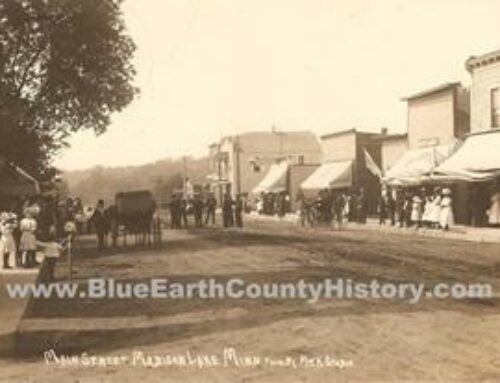Excerpt from The Heritage of Blue Earth County by Julie Schrader, Topic 22, available in the Research & Genealogy Center.
“Three steamboats ascended the river in connection with the treaty that year. The Excelsior arrived the last of June carrying the Commissioners and their attendants and supplies to the treaty grounds. on June 20th, of that year the Benjamin Franklin No. 1 carried a number of visitors from St. Paul to witness the signing. In October, the Uncle Toby carried the first consignment of good to the Indians following the treaty.
“In 1852, three steamboats made seven trips to Mankato. The Tiger made three trips in April and May and the Black Hawk made three trips later in the season. The Jenny Lind made one trip. The three steamboats had a goodly number of passengers and a good load of freight each trip.
“The first boat to ascend the Minnesota in 1853 was the Greek Slave, a sidewheeler. She arrived in Mankato on April 7th with 150 passengers and a large quantity of freight. In the spring of 1853 two events occurred which greatly stimulated traffic on the river. Once was the establishment of two Sioux agencies on its headwater and the other was the location of Fort Ridgely in the same locality. On April 26th the West Newton took on board two companies of U.S. troops at Fort Snelling and conveyed them to the site of the new fort. The Tiger, Shenandoah and the Clarion, each with barges in tow, went up the Minnesota, loaded with the baggage of the soldiers and materials and supplies for the new fort and the Indian agencies.
“The river stayed high all through the summer of 1853 and 49 departures were made from St. Maul fro the Minnesota. The next year was unusually dry and few trips were made by steamboat. Most of the traffic above the rapids had to depend on the keel boats. They were 50 to 60 feet in length, 10 to 12 feet wide and had 4 to 5 foot sides along the top of which were attached a plank walk for the use of the polemen. A small cabin was built in the stern for the cook and in wet weather a tarpaulin was spread over the goods. The full crew consisted of a captain, who also acted as steerman, ten to twelve polemen and a cook. The usual speed up the stream was 12 to 14 miles a day. A better speed was made going downstream. Arthur G. Myrick had two such boats built in 1853. In 1854 these boats brought the necessary supplies to Fort Ridgely and the Indian Agencies.”




Leave A Comment